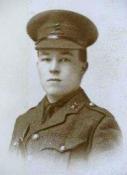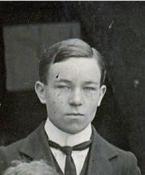
|
The King's School Canterbury |
Roll of Honour |
| 2nd Lieutenant Charles Cecil FIELD | |
|
8th (Service) Battalion Queen's Own (Royal West Kent Regiment) attached to Y Company, 2nd Battalion Suffolk Regiment Date of birth: 21st May 1895 Date of death: 30th March 1916 Killed in action aged 20 Buried at Voormezeele Enclosures No 1 and No 2 Plot I Row D Grave 3 |

|
| He was born at Ranskill in Nottinghamshire on the 21st of May 1895 the second son of the Reverend Walter St John Field and Ida (nee Hornung), later of Fordcombe Vicarage, Tunbridge Wells in Kent. He attended the King's School Canterbury from May 1910 to July 1914 becoming a monitor in 1913 and for two terms he was the Captain of Holme House. On leaving King's he had intended to go to Keble College Oxford in October 1914, having obtained one of the Archbishop's Missionary Exhibitions with the intention of becoming a missionary, but his plans were interrupted by the outbreak of war. Instead he enlisted into the army at 66 Victoria Street, Westminster as Private 338 in the 19th (Service) Battalion Royal Fusiliers (2nd Public Schools), University and Public Schools Corps on the 15th of September 1914. At a medical examination, which was held on the same day, it was recorded that he was five feet five inches tall and weighed 150lbs. He was posted to Epsom for training where he was billeted at 71 Lower Court Road, Epsom. He applied for a commission in the Queen's Own (Royal West Kent Regiment) and was commissioned as a 2nd Lieutenant in the 9th (Reserve) Battalion of the Royal West Kent Regiment on the 9th of January 1915. He was posted to the 8th Battalion in July 1915. He embarked for France on the 7th of October 1915 where he was attached to the 2nd Battalion Suffolk Regiment who were in billets at Stratzeele in Belgium. He was placed in charge of a machine gun section. On the 27th of March 1916, while his battalion was resting at Ouderdom, a series of mines were fired by the British at St Eloi and the battalion was moved up by bus to Dickebusch where they waited to move forward in a hail storm. On the night of the 28th the 2nd Suffolks moved up the long communication trench to the craters under heavy shellfire. When it got light they discovered that part of the trench on the right of their line was still held by the Germans. Early the following afternoon a bombing part under 2nd Lieutenants Bennett and H.P. Gardham attempted to clear this position but after advancing twenty yards up the trench they were frustrated by a barricade the Germans had constructed as a block in the trench. At noon on the 30th of March 1916 2nd Lieutenant Bennett and Charles Field led a bombing attack which was to link up with the 10th Battalion Royal Welsh Fusiliers and to cut off a party of around fifty Germans in a nearby crater. After a hour of fighting they were forced to retire due to the level of sniping from the defenders. During the attack Charles Field led his machine gun section forward in a gallant attempt to mount his machine gun in the open in order to cover the attack. He was killed by a sniper from a range of fifty yards. Nine other ranks were also killed during the attack. His father received the following telegram dated the 2nd of April 1916: - "Deeply regret to inform you that 2/Lt C.C. Field Royal West Kent Regiment was killed in action Mar 30th. Lord Kitchener expresses his sympathy. Please send name and address of officers next of kin." His commanding Officer wrote:- "He was the most conscientious officer it has been my pleasure to command, He was liked by everybody and I know his men would follow him anywhere." The Captain of his company wrote: - "He was to them a cheery comrade and friend they can ill afford to lose." The Cantuarian wrote:- "Both officers and men remarked on the cheerfulness which he displayed, even in the face of the greatest dangers. We sympathise most sincerely with his relatives and friends in their great loss." He is commemorated on the war memorial at Fordcombe and in the churchyard. He is also commemorated on the memorial at Keble College Oxford. |
|
 | |
| Holme House |
Back